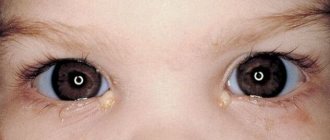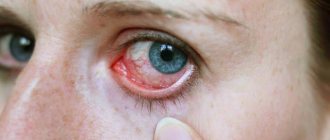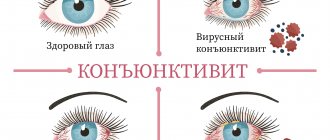Allergic conjunctivitis occurs as a response of the body to the action of any irritant. Medicine currently knows many types of different allergens. First of all, signs of irritation appear in the eyes. Let's look at the most common types of allergic reactions and how to treat them in adults.
The mechanism of development of the disease is associated with the individual sensitivity of the body when a certain allergen comes into contact with the mucous membrane of the eyes.
In this article
- Symptoms of allergic conjunctivitis
- Types of allergic conjunctivitis in adults
- How is allergic conjunctivitis treated in adults?
For example, when a birch tree blooms, millions of people feel normal, and only a few experience an allergic reaction. Conjunctivitis caused by exposure to allergens immediately manifests itself as irritation of the organs of vision - this is the first sign of various types of this disease. In this way, the immune system responds to an antigen that poses a danger to people who are prone to an individual reaction to it.
How to distinguish between allergies and SARS-CoV-2–conjunctivitis?
In addition to redness and swelling of the mucous membranes and eyelids, lacrimation and burning, a characteristic hallmark of allergic conjunctivitis is itching. Runny nose, nasal congestion and sneezing are common. Especially if a person has a history of similar inflammation in the spring in previous years.
With SARS-CoV-2 conjunctivitis, itching and severe lacrimation are usually not observed. Redness of the eyes, swelling of the mucous membranes, burning, and mucous discharge from the eyes (thicker and stickier than tears) may occur. A hallmark of SARS-CoV-2 conjunctivitis is an increase in body temperature. You should also be alert to accompanying cough, difficulty breathing, shortness of breath, discomfort and pain in the chest, loss of smell and taste.
Types of allergic conjunctivitis in adults
Allergies that lead to red eyes are common. Medical statistics indicate a noticeable increase in the number of allergic manifestations in different countries of the world. This is due to the general deterioration of the environment, a decrease in the quality of products and other factors. Allergic conjunctivitis is a hallmark of the following types of allergies:
1. Hay fever, or seasonal allergic rhinoconjunctivitis. It is also popularly called “hay fever”. The most common type of allergy that occurs to the pollen of some flowering plants: cereals, weeds, trees (birch, alder, linden).
The following symptoms are characteristic of hay fever:
- hyperemia and swelling of the conjunctiva;
- excessive lacrimation, itching, irritation in the eyes;
- nasal congestion, cough.
Often, the signs of hay fever are confused with manifestations of ARVI and they do not immediately consult a doctor, trying to be treated with completely different drugs. Its difference, for example, from viral conjunctivitis or a cold may be indicated by the absence of temperature, which does not occur with seasonal rhinoconjunctivitis.
2. Allergic conjunctivitis that occurs upon contact with animals. Strictly speaking, irritation is not due to fur or fluff, as the vast majority of people believe. Allergies can even occur to hairless cats, for example, Sphynxes, since the source of irritation for the mucous membrane of the eyes is the secretions of various glands of the animal’s body. In this case, the reaction occurs more often when in contact with cats than with dogs. Felines constantly lick themselves, and particles of saliva remain on their fur, causing irritation. An allergy may not immediately occur upon first contact with an animal. Often the first symptoms appear some time after the animal appears in the house. In the preceding period, the body is sensitized by allergen proteins.
3. Drug-induced allergic conjunctivitis. An inflammatory reaction of the eyes occurs while taking any drug, and can manifest itself both in an acute form (a few hours after the start of use) and in a protracted form - several weeks after the start of the course. Most often, allergic conjunctivitis is diagnosed while taking antibacterial drugs and local anesthetics, as well as when liquid medications are instilled into the eyes.
4. Papillary allergic conjunctivitis of the eyes occurs when contact optics are used incorrectly. Most often, this complication occurs when wearing extended or continuous mode lenses, as well as when using traditional models with a replacement period of 6-10 months. Such optics require careful regular care and, if the operating rules are violated, cause irritation to the visual organs. A distinctive sign of the disease is the appearance of papillae on the conjunctiva of the upper eyelid, sometimes reaching a size of 0.5 mm, along with the usual symptoms of allergic conjunctivitis - swelling and hyperemia of the eyelids, mucous discharge. Papillary conjunctivitis of the eyes in most cases is a reaction to protein deposits from the tear fluid on the surface of the contact lens, and their amount directly depends on the wearing mode and the timing of replacement of the optics. At the same time, the use of contact lenses begins to cause severe discomfort, and the quality of vision decreases significantly.
Allergic conjunctivitis is also caused by other irritants that surround us in everyday life:
- dust mites;
- some components included in cosmetics and perfumes;
- smoky and polluted air;
- household chemicals, etc.
We have briefly listed the most common causes that can cause an inflammatory reaction in the eyes. In total, about 20 thousand allergens have been identified to date! This is greatly facilitated by the widespread deterioration of the environmental situation, water and air pollution, and poor quality of products. Under the influence of these factors, a person’s immunity weakens and begins to react unconventionally to certain substances, considering them dangerous to the body.
What to do if eye inflammation occurs?
First of all, don’t panic! Based on the symptoms described above, try to determine the possible cause of eye inflammation. As a rule, SARS-CoV-2 is an extremely rare cause of viral conjunctivitis, and in the absence of fever, cough, shortness of breath and other accompanying signs of infection, it is unlikely.
In the case of allergic conjunctivitis, local use of antihistamines in the form of eye drops and/or systemic use in the form of tablets or drops for children is possible. Cool compresses and moisturizing eye drops can be used to relieve symptoms.
There is no adequate treatment for viral conjunctivitis (including SARS-CoV-2 conjunctivitis). Antiviral drops available on the Russian market have no proven effectiveness and are not included in international treatment protocols. To facilitate the period of independent recovery, it is possible to use cool compresses and moisturizing drops.
Diagnostics
Diagnosis of allergic conjunctivitis is carried out simultaneously by an ophthalmologist and an allergist-immunologist, who should conduct treatment. It includes several stages:
- collection of information - complaints of mother and child, family history;
- identifying the exact causes of the disease - the connection between external irritating factors and the child’s reaction;
- clinical picture - examination;
- microscopic examination of discharge from the eyes, where eosinophils are always found during an allergic reaction;
- general clinical blood test, in which the level of eosinophils is also increased;
- blood test for specific immunoglobulin E;
- performing skin allergy tests (patch test, skin prick test, scarification test and scarification-patch test) in order to clarify the allergen - used only for children over 4 years of age;
- a blood test from a vein to determine the range of substances to which the child is allergic;
- nasal, conjunctival and sublingual tests are performed rarely and only during remission;
- accompanying examinations of the child’s gastrointestinal tract, stool testing for worm eggs and scrapings for enterobiasis.
When should you contact an ophthalmologist?
- When complaints increase and there is no positive dynamics for several days.
- Pain in the eye.
- Deterioration of vision.
- Copious purulent and mucous discharge from the eyes.
If, in addition to eye inflammation, there are accompanying symptoms of infection (fever, difficulty breathing, shortness of breath, cough), or you have had contact with someone who has COVID-19 in the last 2 weeks, you should be wary of a possible coronavirus infection.
In conclusion, I would like to note the importance of frequent and proper hand washing. Avoid touching your eyes and face with your hands.
Gasanova Zamira Elmanovna , ophthalmologist
Causes
Today, allergic conjunctivitis is the most common disease among the total number of eye pathologies. It is believed that up to 25% of the entire world population suffers from some form of inflammation of the conjunctiva, and more than half
In this article
- Causes
- Classification of allergic conjunctivitis
- Diagnostics
- Treatment of allergic conjunctivitis
patients exhibit symptoms of allergic conjunctivitis. Statistics show that in recent years the prevalence of allergies has increased several times. At the same time, treatment methods still remain unable to completely prevent and prevent the occurrence of allergies. Today, it is considered as a lifelong and incurable diagnosis, the causes of which vary greatly depending on the body’s resistance to certain allergens. These may include: increased sensitivity to ultraviolet rays, pollen from plants during their flowering period, disturbances in the functioning of the human immune system, as well as other external and internal factors.
Conjunctivitis with a runny nose
The concepts of conjunctivitis and runny nose are compatible, since the presence of pathogenic microflora in the nasopharynx often spreads to the mucous membrane of the eyes. There are 3 types of runny nose and inflammation of the conjunctiva - bacterial, viral and allergic. General symptoms include profuse lacrimation, photophobia, and swelling of the eyelids. To get rid of ailments, it is recommended to consult a doctor who will diagnose, prescribe medications and give preventive recommendations.
Allergies
The most common allergic diseases are so-called atopic and are characterized by the fact that the allergic reaction in them occurs according to the reagin type and, accordingly, is immediate.
The most common atopic diseases are allergic rhinitis, allergic conjunctivitis, and atopic bronchial asthma. Allergic rhinitis is a disease of the nasal mucosa, which is based on allergic inflammation caused by causally significant allergens and accompanied by rhinorrhea, obstruction of the nasal passages, itching in the nasal cavity, and sneezing.
According to foreign and domestic authors, from 10 to 20% of the population suffers from allergic rhinitis, and the incidence is constantly growing.
There are seasonal and year-round allergic rhinitis. Seasonal rhinitis is caused by exposure to pollen and fungal allergens. The main allergens that cause year-round allergic rhinitis are components of house dust (mainly dust mites of the genus Dermatophagoides), library dust, as well as the epidermis of domestic animals and birds, mold fungi, and, less commonly, food and drug allergens. As a result of the influence of mediators (mostly histamine), swelling of the mucous membrane and increased permeability of the epithelium occurs, which leads to characteristic symptoms: nasal congestion, itching in the nasal cavity, sneezing, rhinorrhea. In 50% of patients, the early stage of allergic inflammation (immediately after exposure to the allergen) is replaced by a late stage, developing after 4-6 hours. For each patient, the severity of a particular symptom may be different. Conventionally, patients can be divided into two groups: some have more pronounced rhinorrhea and sneezing, and the other has nasal congestion. Patients of the second group often use vasoconstrictor drops for a long time. In allergic rhinitis, there is also nasal hyperreactivity, i.e. increased sensitivity to nonspecific irritants - household chemicals, strong odors, changes in temperature. In addition, other symptoms may be observed: swelling in the face, headache, pain in the middle ear, decreased sense of smell, weakness, irritability. The most common complications of allergic rhinitis are polyposis of the nose and paranasal sinuses, catarrhal or purulent sinusitis/ethmoiditis.
The diagnosis of allergic rhinitis is made on the basis of medical history and the results of a general clinical and allergological examination. When interviewing the patient, it is necessary to clarify in what situation he notes a deterioration in his condition. To compile a complete picture, it is necessary to carefully collect information about the patient’s place of residence and work, the presence of animals in his home, occupational hazards, etc. Suspicion of year-round allergic rhinitis arises in the case of constant contact with an allergen. With seasonal allergic rhinitis, the exacerbation of the disease coincides with the period of flowering of plants or sporulation of fungi. When analyzing seasonality, it is necessary to take into account the fact that the spring-autumn season is a period of active reproduction of house dust mites, therefore manifestations of increased sensitivity to mite allergens can also be seasonal. It is worth paying attention to the family history. It is necessary to clarify whether the patient has other atopic diseases: allergic conjunctivitis, bronchial asthma, atopic dermatitis, etc., since such combinations are quite common. Important criteria may be the elimination effect and the effectiveness of antiallergic drugs.
Examination of a patient with allergic rhinitis includes: examination of peripheral blood and material from the nasal cavity (smear) for the presence of eosinophilia, rhinoscopy, rhinomanometry, specific provocative tests (skin and nasal) with causally significant allergens and histamine, laboratory examination methods - determination of general and specific IgE in blood serum.
Allergic rhinitis is often accompanied by allergic conjunctivitis. In extremely rare cases, allergic conjunctivitis is not combined with rhinitis. The inflammatory reaction of the conjunctiva is caused by the same allergens as allergic rhinitis. In this case, redness of the conjunctival mucosa, lacrimation, a feeling of sand in the eyes are noted, and in severe cases, swelling of the eyelids. Allergic conjunctivitis can be complicated by a purulent bacterial infection, which leads to more severe consequences. The specific diagnosis of allergic conjunctivitis is the same as for allergic rhinitis. A conjunctival test with causally significant allergens is used as a provocative test.











